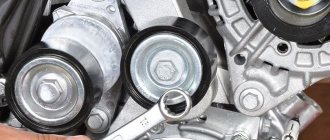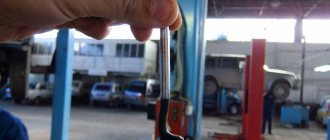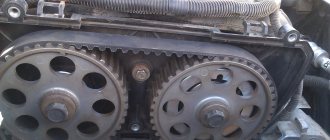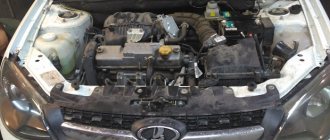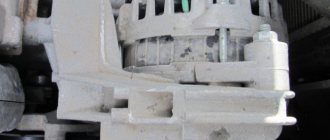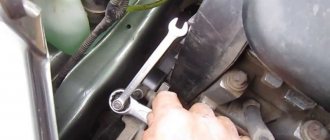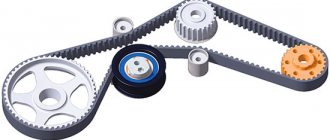Belts and rollers
Alternator belt roller with tension bracket Power steering + Air conditioning QZ0403954
Drive belt for auxiliary units Lada Largus 16V (21129 VAZ engine), 6PK1709
Timing belt roller engine 1.6 16V (parasitic) Klaxcar France rx26020 analogue 7700107150 (pcs)
Belt (6PK1823XS, 6PK1822) generator GATES engine K4M 16cl Lada Largus, Renault Logan
Contitech alternator belt for Largus, engine VAZ-11189 1.6 (8 cells) with power steering and air conditioning
Alternator drive belt with tensioner, engine HR16DE-H4M Renault Duster, Almera (G15)
Timing roller set Marel dv. K4M for Lada Largus, Renault Logan, Duster, Sandero
(Engine Renault K7M 8kl. without power steering and without air conditioning)
Alternator drive belt for Lada Largus with engine VAZ 21129 16kl (AC+power steering) analogue 8450090469
Timing tensioner pulley Marel dv. K7M for Lada Largus, Renault Logan
2163-13-12-03
Remove the accessory drive belt.
Remove the accessory drive belt.
Remove the accessory drive belt.
Marking of the drive belt for auxiliary units of a car with power steering and air conditioning is 5K 1747 (five-strand, length 1747 mm). When replacing the belt, the support and tension rollers must also be replaced.
Belts and rollers: purpose, types
In the design of Lada Largus, Renault Logan, as well as other models, belts and tension rollers are used to drive auxiliary units. The former ensure the transmission of torque from the engine shaft, and the latter are used for tension. Failure of certain consumables leads to de-energization of the on-board network of a Renault or Lada car. To prevent this from happening, it is necessary to periodically monitor their condition and, if necessary, promptly replace them with new analogues.
Other disadvantages of the model
The gasoline consumption of the Lada Largus is higher than that of the Kalina station wagon by 1.5 liters, with a weight difference of only 80 kg. Engine vibration occurs as soon as the tachometer needle reaches 1500 rpm. The rpm often jumps or drops to 500. When driving at a speed of more than 90 km/h, the ears begin to pop, like in an airplane during takeoff. This upsets many car enthusiasts, because at these moments they want to stop the trip and get out of the car.
The lack of rear mudguards is a big drawback of the presented model. Ball joints pressed into the arms will make it difficult to repair the suspension in the future. The gap between the fender and the front bumper must be covered with some kind of gasket to maintain cleanliness. Dirt constantly accumulates in this area.
Limited functionality as standard - no ABC or front windows. During rainy weather, the windows constantly fog up; in this case, they need special treatment. In winter, the accelerator pedal freezes, the interior warms up very slowly, and the engine cools down quickly. Pump malfunctions occur when the car's mileage is more than 30,000 km; there are no floor mats in the cabin.
Sources
- https://www.dvigokcomtrans.ru/avto/vaz/vaz_largus/
- https://lada-avtovaz.ru/remont-generatora-na-lada-granta/
- https://expertvaz.ru/lada-largus/problemy-minusy-nedostatki.html
Alternator belt types:
Depending on the specific modification of Largus Cross or another model, the following types of Renault or Lada alternator belts are used:
- Four-stranded. On Lada or Renault cars without power steering and air conditioners, equipped with engines with 8 valves, products of the 4RK715 series are used.
- Five-rakes. Drive belts for 5RK generators with a length of 1110 mm are intended for generators installed on vehicles without air conditioning or power steering, which are equipped with K7M engines with 8 valves.
- poly-V-type belts : Belts with a length of 1200 are used on models equipped with K4M engines with 16 valves and power steering, but without air conditioning.
- Products with a length of 1820 mm are suitable for generators installed on engines with 8 or 16 valves together with power steering and air conditioners.
- Belts 837 mm long (analogues of Renault 117200593R) are used for generators installed in conjunction with 8-valve engines on cars with air conditioning, but without power steering.
2163-13-12-01
... we put a spanner or a 13-mm socket on the tension roller mounting bolt and turn the roller bracket clockwise, overcoming the force of the tensioner spring, until the hole in the roller bracket aligns with the recess in the device body (for clarity, shown on a removed engine).
... we put a spanner or a 13-mm socket on the tension roller mounting bolt and turn the roller bracket clockwise, overcoming the force of the tensioner spring, until the hole in the roller bracket aligns with the recess in the device body (for clarity, shown on a removed engine).
... we put a spanner or a 13-mm socket on the tension roller mounting bolt and turn the roller bracket clockwise, overcoming the force of the tensioner spring, until the hole in the roller bracket aligns with the recess in the device body (for clarity, shown on a removed engine).
Lada Largus replacement of the drive belt for auxiliary units 8 and 16 valves
Lada Largus, replacing the belt on an engine with 8 and 16 valves is different. Today we will talk about replacing the drive of auxiliary units on both types of Lada Largus engines. The manufacturer requires replacement every 60 thousand kilometers or after 4 years of operation, if the 60 thousand mark has not been passed. In addition, the drive belt patterns with air conditioning and without air conditioning are different. Our article today is about all this.
Timing for belt replacement according to regulations and experience
Many people have encountered the problem of a belt breaking on the highway even on “eights” and “nines”, and now they believe that it is better to play it safe and change the belt already at 50 thousand mileage. But as practice shows, this concern is not always justified and many Largus models can easily travel over 100,000 km without replacement. Much also depends on the specific use of the car - in the ragged city rhythm, wear always occurs faster than on the highway. The manufacturer in the service book recommends replacement no earlier than 120,000 km. However, from the experience of car enthusiasts, we can say that the belt usually exhausts its service life by 100 thousand km. If you don’t want to use the services of a tow truck one day, it’s better to change it in advance. If you have doubts about whether it is time to change the belt, simply assess its visual condition by opening the hood of the car. If there are cracks on the surface, traces of abrasions, delamination or protruding cord threads are visible, then it is necessary to replace it as soon as possible. Even if there are no external signs of wear, it is still worth periodically checking the degree of tension, since an overtightened or sagging belt can also lead to breakage.
Belt replacement Lada Largus 8 valves with air conditioning
Belt diagram with power steering and air conditioning.
- 1 - auxiliary drive pulley
- 2 - tension roller
- 3 — power steering pump pulley
- 4 — generator pulley
- 5 - air conditioning compressor pulley
- 6 - support roller
The tension of the drive belt for Lada Largus auxiliary units with power steering and air conditioning is automatically adjusted by a tensioner. To replace the belt, remove the right mudguard of the engine compartment.
To loosen the belt tension, from below the car we put a spanner or a 13-mm socket on the tension roller mounting bolt and turn the roller bracket clockwise, overcoming the force of the tensioner spring, until the hole in the roller bracket and the recess in the device body are aligned.
We fix the roller bracket by inserting a “6” hexagon or a rod with a diameter of 6 mm into its hole and the recess in the tensioner body.
Remove the accessory drive belt.
Marking of the drive belt for auxiliary units of a car with power steering and air conditioning is 5K 1747 (five-strand, length 1747 mm). When replacing the belt, the support and tension rollers must also be replaced.
To replace the support roller with a spanner wrench or a 13-mm socket, unscrew the bolt securing it and remove the bolt with the protective cover of the roller. Remove the support roller.
Similarly, unscrew the fastening bolt and remove the tension roller. If it is necessary to replace the tensioner (for example, if a spring breaks), use a “13” head to unscrew the two bolts securing the tensioner housing and remove the tensioner assembly with the roller.
Automatic tensioner assembly in the next photo
Install the removed parts in reverse order. Before installing the belt, the tension roller bracket must be turned clockwise and locked (see above).
Removing and replacing the generator
Removal of the generator, with or without air conditioning, is required only in case of repair or replacement of the generating device on the Lada Largus model. It is better not to do this unless absolutely necessary.
In this case, you can remove the generator in different ways. This directly depends on the configuration in which the Lada Largus is presented.
The options may be the following, which affect the dismantling and installation scheme:
- K7M engine without power steering and air conditioning;
- K7M engine with power steering, but without air conditioning;
- with power steering and air conditioning;
- K4M engine without air conditioning, but with power steering.
But regardless of the configuration and equipment, before removing the generating device on all versions, you need to do the following:
- install the machine on a lift with a lifting capacity of at least 3.2 tons;
- turn on the handbrake;
- turn off the ignition;
- lift and securely secure the hood;
- disconnect the negative terminal from the battery.
Now each situation must be considered separately. This will clearly allow you to understand exactly how to remove and replace the generating device.
K7M engine without air conditioning and power steering
With this variation of equipment, the dismantling and replacement procedure is as follows:
- remove the front right wheel;
- remove the engine splash guard on the right side;
- remove the front arch skin from the right front wheel;
- remove the protective cap from the nut;
- disconnect the wiring harness from the generator;
- using a 13mm socket, unscrew this nut under the cap;
- disconnect the wire lugs from the existing B+ terminal on the generator;
- cut the old belt and remove it, since it is still not suitable for reuse;
- Using a 10mm socket, unscrew the mounting bolts from the bottom and top that hold the generator to the bracket;
- remove the problem unit;
- replace the tension and support rollers;
- secure the new drive belt;
- tighten the mounting bolts;
- for the bolt fixing the generator to the bracket, use a torque of 21 Nm;
- for wire fastening nut 14 Nm.
At this point the replacement can be considered complete. Check the node for correct operation. If everything works correctly, then complete the full assembly.
K7M engine without air conditioning, but with power steering
Here the instructions will look like this:
- remove the protective cap from the nut, disconnect the wiring harness and unscrew the nut itself with a 13mm head;
- disconnect the wire lugs from the generator terminal B+;
- Unscrew the adjustment bolt and the upper bolt securing the adjustment bar approximately 3-4 turns using a 10mm socket;
- dismantle the front right wheel, remove the mudguard and arch casing;
- taking the head at 10, make 3-4 turns of the lower bolt securing the bar to loosen the belt tension;
- remove the belt itself;
- Using the same head, unscrew the lower mounting bolts that hold the generator on the bracket;
- unscrew the upper bolt connecting to the bracket;
- remove the generating device from the machine;
- reassemble in reverse order;
- for attaching the generator bolt to the bracket, use a torque of 21 Nm;
- for the tension roller adjustment bar mounting bolt, also 21 Nm;
- the generator wire connection nut requires a torque of 14 Nm.
In addition to replacing the belt, you will also need to install a new tension pulley.
Equipment with air conditioning and power steering
This is quite a good package, since here the driver can count not only on easier rotation of the steering wheel due to the hydraulic booster, but also on comfortable conditions in the cabin created by climate control equipment.
As for replacing the generator, the procedure is as follows:
- remove the front right wheel;
- remove the front bumper;
- using a 16mm spanner, turn the tension roller clockwise;
- lock the tension roller using a 6 mm hexagon;
- remove the drive belt;
- unscrew the air deflector fastenings and then remove the reflector itself;
- Using a 10mm socket, remove the upper mounting bolts of the radiator bracket to the body;
- remove the brackets;
- remove the cooling radiator together with the air conditioner condenser from the lower mounts;
- to do this, carefully move it towards the left wing;
- Using a 13mm wrench, unscrew the fastening nut of the generator wire and remove the wire;
- disconnect the wiring harness from the generator;
- taking the head 10, unscrew the fastening bolt that holds the generating device;
- use the same head to unscrew the lower fastening and remove the generator from the car;
- perform assembly with a new device in the reverse order;
- tighten the bolt securing the generator to the bracket to a torque of 21 Nm;
- the wire fastening nut requires a torque of 14 Nm.
This is not to say that the procedure is easy. Some people are scared by the fact that it is necessary to remove the front bumper and radiator. Yes, here the scheme turned out to be not the most convenient. Although in reality, almost every Lada Largus owner, having theoretical knowledge and at least a little practical experience, will be able to cope with the task.
If you are afraid to take risks or are not confident in your own abilities, then it is better to send your Lada Largus to a specialist car service center.
K4M engine without air conditioning, but with power steering
In the case of this configuration of the domestic Lada Largus station wagon you will need:
- remove the front wheel on the right side, remove the mudguard and remove the alternator belt;
- unscrew the nuts securing the fuel rail protection, and then remove the protection;
- disconnect the fitting from the fuel rail pipe;
- Using a 13mm wrench, unscrew the nut securing the generator wire and remove the wire itself;
- disconnect the wiring harness connector;
- take the wiring aside;
- Using a 13mm head, unscrew the power steering tube mounting bolt on the cylinder block;
- Use a 10mm head to unscrew the bolt that secures the bracket for fixing the power steering pipeline to the generator;
- remove the bracket;
- unscrew the upper mounting bolt of the generator using a 10mm socket;
- Using the same head, unscrew the lower mounting bolt;
- remove the generator upwards along with the lower fixation bolt;
- perform assembly in reverse order;
- for the bolt securing the generating device to the bracket, apply a torque of 21 Nm;
- a torque of 22 Nm goes to the bolt securing the power steering pipeline bracket to the generating device;
- tighten the generator wire fastening nut to 14 Nm;
- fuel rail protection nut also with a force of 21 Nm;
- install a new belt;
- complete the assembly of all dismantled elements.
Finally the work is completed.
Belt replacement Lada Largus 8 valves without air conditioning
Belt diagram without air conditioner.
- 1 - auxiliary drive pulley
- 2 — tension roller with bracket
- 3 - adjusting bolt
- 4 — tension roller bracket mounting bolt
- 5 — generator pulley
- 6 — power steering pump pulley
- 6 - drive belt
Checking the belt tension of auxiliary units of a car with power steering and without air conditioning must be performed using a special tool at a dealer service. Considering that if you replace it yourself, you will have to change the belt outside of the dealership service center, we will show you a way to approximately estimate the belt tension.
Remove the right mudguard from the engine compartment. From below the car, use your thumb to press the belt in the middle between the pulleys of the power steering pump and the crankshaft. With a pressing force of 10 kgf, the belt deflection should be 6–8 mm. To tension the belt, loosen the two bolts 4 securing the tension roller bracket and rotate adjusting bolt 3 clockwise. Having tensioned the belt, tighten the bolts securing the tension roller.
Attention! Excessive belt tension leads to premature failure of the belt and tension roller, as well as accessory bearings.
To replace the belt, turn adjusting bolt 3 counterclockwise several turns and loosen bolts 4 securing the tension roller bracket. Having loosened the belt tension, remove it from the pulleys. Marking of the drive belt for auxiliary units of a car with power steering and without air conditioning is 5K 1110 (five-strand, 1110 mm long). When replacing a belt, you must also replace its tension roller. Install the auxiliary drive belt in reverse order.
Attention! The drive pulleys for the auxiliary units, generator and power steering pump are six-strand, and the drive belt is five-strand.
We lay the belt on the pulleys so that it is shifted to the inner edge of the pulleys, and the outer groove of the pulleys remains free. We adjust the belt tension using the method described just above.
Drive belt tightening for Lada Largus
The installation diagram and location of the generator belt suggests that the Largus system automatically, that is, independently, tensions the element. This means that no additional interventions or manipulations are required.
This only applies to trim levels with air conditioning and power steering. You really don't have to do anything here.
If you have a different configuration, then you will still have to tighten the alternator belt yourself.
But first you need to understand that the part generally needs tightening. In general, to check the tension, the official instruction manual states the need to use a strain gauge tester. The only problem is that such equipment is available only at dealerships. There is absolutely no point in looking for and buying it for personal use. Here you can resort to another method. Namely:
- remove the mudguard from the engine;
- move under the car, which needs to be hung on a lift or placed over a hole;
- press on the lower branch of the belt so that it bends by 7-8 mm;
- if the belt moves easily, the tension is weak;
- loosen the 2 bolts securing the tension element bracket;
- turn the adjustment screw counterclockwise;
- achieve the desired tension level;
- tighten previously loosened bolts;
- Try not to tighten the part too much, as this will cause it to fail prematurely.
This completes the tightening. Check the result of the work done in action.
Belt replacement Lada Largus 16 valves
Drive belt diagram with air conditioner..
The Lada Largus belt tension is adjusted automatically by a tensioner. To replace the belt, remove the right mudguard of the engine compartment. To loosen the belt tension, from below the car we put a spanner or a “15” socket on the tension roller mounting bolt.
Turn the roller bracket clockwise, overcoming the resistance of the tensioner spring, and remove the belt from the support roller. Remove the accessory drive belt from the pulleys. The marking of the drive belt for Largus auxiliary units with air conditioning is 6РК 1822 (six-strand, 1822 mm long). When replacing the belt, the support and tension rollers must also be replaced.
To replace the support roller with a spanner or a 13 socket, unscrew the bolt securing it and remove the outer cover of the roller. Remove the support roller and its inner cover.
Similarly, remove the tension roller. If it is necessary to replace the tensioner with a “10” head, unscrew the two bolts and remove the tensioner assembly with the roller.
Install the parts in reverse order. When installing the belt, place it on the pulleys and place it under the tension and support rollers in accordance with the diagram above.
Source
How to install a new belt on a car
Place a new part on the crankshaft pulley. Install the belt onto the pulley teeth by hand. In the same way, hang the belt on the pulley towards the camshaft. Place the remaining part of the timing belt behind the tension roller.
Now tighten the belt drive. Turn the roller counterclockwise and secure it with the bolt. Then secure this bolt. Rotate the crankshaft until the marks align.
Let's take a closer look at how to remove the belt on an 8-valve engine:
- place the Lada Largus car on the lift;
- remove the terminals from the battery, thereby stopping the operation of the on-board network;
- take a suitable wrench and turn the crankshaft so that the marks on the pulley and timing cover match;
- fix the shafts so that they do not rotate;
- take the 10th key and remove the protective cover;
- remove the pulley that is responsible for the belt drive;
- Using the 17th wrench, loosen the tension roller nut;
- remove the tension roller and timing belt.
How to work with a 16-valve engine:
- Hang up the car, stop the final drive and remove the crankcase protection.
- Under the area where the Lada Largus engine is located, install something as a support.
- Use the 19th key to remove the right side of the support. Watch how the bolts are located in this place so as not to get confused later during assembly, since the bolts have different lengths.
- Remove the covers to protect the timing belt on the Largus car.
- Lock the crankshaft.
- Take the 18th key and remove the drive pulley.
- Set the piston to the normal TDC position, and then remove the belt drive, holding the bolt, and rotate the crankshaft.
This is how you remove the belt on a 16-valve engine.
Which timing belt is suitable for a Lada Largus car with any number of valves? In addition to the fact that you need to properly dismantle the belt, the quality of the materials from which it is made has a great influence on its service life.
The official manufacturer of materials for Largus is Gates. You can also choose Bosch, Dayco, Pilenga. There is no point in relying on reviews from owners about the quality of this or that manufacturer; follow the recommendations of official dealers. Trust your experience.
When changing the timing belt on Largus, also replace auxiliary spare parts. Replacing a belt is not a difficult task.
Don't skimp on the timing belt. Saving 200-300 rubles or postponing its installation until later, everything can turn into an expensive repair.
Lada Largus drive belt rollers
17206746R GENERATOR BELT +2 ROLLERS KIT K4M (1.6 16kl) and K7M (with power steering and air conditioning) (1.6 8kl) - see also its analogue gates k016pk1823xs
7701478717 ALTERNATOR BELT + ROLLER KIT K4M (1.6 16kl without air conditioning)
7701477517 Alternator belt (5-ribbed) +2 rollers (1.6 8kl) with air conditioning (mainly Logan1)
117201773R GENERATOR BELT + ROLLER KIT K7M/K7J (1.6 8kl) with steering wheel, without air conditioning
K015PK1113 GATES alternator belt kit, engine Renault K4M, K7M for Lada Largus, Renault Logan (power steering, without air conditioner) an.117201773R
According to RENAULT regulations, it is recommended to change drive kits for TO-4: Lada Largus 60,000 km Important!
Our assortment includes belts purchased from the official supplier of spare parts, Renault Russia JSC, this is guaranteed
originality of spare parts. Beware of fakes; the original spare part is always packed in a branded box, and not wrapped in stretch or tape.
And even fake packaging of RENAULT components can only be distinguished from the original by a specialist.
Dear customers, in order to avoid errors when sending an automatic tensioner with a drive belt roller for auxiliary units (8200277606, 8200603359, 8200933753) Lada Largus, Logan, Sandero, Duster, DACIA, Almera (with air conditioning and power steering), in the “Comment” line indicate with air conditioning , with or without power steering, your car model, year of manufacture.
2163-13-12-08
Automatic tensioning device.
Automatic tensioning device.
Automatic tensioning device.
Install the removed parts in reverse order. Before installing the belt, the tension roller bracket must be turned clockwise and locked (see above).
When installing the belt, place it on the pulleys and place it under the tension and support rollers in accordance with the drive diagram.
Attention! The drive pulleys for auxiliary units, generator, air conditioning compressor and power steering pump are six-ribbed, and the drive belt is five-ribbed.
Timing belt roller engine 1.6 16V Lada Largus (parasitic) Quartz analogue QZ0107150
- Manufacturer: Germany
- Quartz: QZ0107150 — 500rub
- Availability: yes
- Applicability: Logan Phase1, Logan Phase2, Sandero, Lada Largus
The AUTO COURIER company has been operating on the market since 2005 and has extensive experience in the selection of spare parts for Renault and other brands. In the process of productive work with manufacturers and suppliers, we managed to establish uninterrupted supplies of spare parts to the Saratov region and other regions of the country. The company focuses on auto parts for Renault Logan, Lada Largus, Renault Duster, Renault Sandero, Renault Megane.
Renault spare parts and accessories from different manufacturers are available: original and third-party manufacturers. The specialists of our online store are highly qualified and have extensive practical experience. By contacting us, you will receive the necessary advice and we will select the necessary spare part for you from the large assortment of our warehouse. You can use any communication method convenient for you and receive the necessary goods at a time convenient for you by ordering delivery. Delivery is carried out both in the Saratov region and throughout Russia in any way convenient for you.
AUTO COURIER is developing a huge warehouse of used automatic transmission units, manual transmission parts, body parts and chassis. We do not ignore oils, lubricants and special chemicals, therefore we purchase very high-quality products from such manufacturers as Pentosin, SRS, ARAL, Petro Canada, Chevron, ELF, Total. The AUTO COURIER company is chosen for its individual approach, speed of work and special attitude towards work and clients. The main goal of the company is mutually beneficial cooperation. Good luck on the road!
Source
2163-13-12-09
We lay the belt on the pulleys so that it is shifted to their outer edge, and the inner groove of the pulleys remains free.
We lay the belt on the pulleys so that it is shifted to their outer edge, and the inner groove of the pulleys remains free.
We lay the belt on the pulleys so that it is shifted to their outer edge, and the inner groove of the pulleys remains free.
After installing the belt, slightly turn the tension roller with a wrench and remove the lock from the hole in the roller bracket and the recess in the tensioner housing. Then, using an 18-inch head with a ratchet, we turn the crankshaft clockwise three turns by the bolt securing its pulley to check the correct position of the belt.
Replacing the accessory drive belt on a vehicle with power steering (without air conditioning)
When does the alternator belt need to be replaced: reasons, signs
In accordance with the maintenance regulations, the drive belt is replaced after 60 thousand km, but not less than after four years. Consumables should be changed regardless of their condition. A characteristic sign of the need to change the Renault or Lada alternator belt is whistling sounds when turning on the headlights, heater or other increased load on the on-board network. Sometimes this noise appears when the belt is loosened due to the loosening of the tension pulley bracket.
Alternator belt Lada Largus - types and replacement on different types of engines
To transmit the mechanical energy of torque from the crankshaft to the generator, which generates the necessary electricity to power the car, the generator belt on the Lada Largus is used. The drive is installed on the generator and crankshaft pulleys. Depending on the design features of the engine and the availability of additional equipment, this part serves as a drive for the air conditioner and power steering. This does not change the principle of operation.
How to replace the belt on a Largus with power steering and air conditioning?
Let us immediately note that the tension of the transmission element of the drive of the generator unit in this version of the equipment is adjusted autonomously due to the presence of a special device.
To replace the drive belt in LADA Largus we perform the following manipulations:
- We dismantle the dirt protection panel of the motor, located on the right side of the unit.
- We arm ourselves with a spanner wrench (or better a socket) with dimension “13”, with which we grab the tension element bolt. We press with a clockwise rotating force and, overcoming the resistance of the spring built into the assembly, we bring the bracket until the hole in it aligns with the same recess in the body.
- Holding the key firmly in the achieved position, insert any rod with a diameter of 6 mm into the alignment of the holes. Here, a hex key with a dimension of “6” is perfect as such a locking device.
- When the tensioner is fixed, the tension force on the belt disappears, and the consumable element can be removed from the units.
- During this procedure, it is possible to check and, if necessary, replace the tension roller and its supporting counterpart.
- Installation is carried out in the reverse order of removal. During this manipulation, we follow the following algorithm: first we lay the belt on the pulleys, then we place the corresponding branch of the product under the tension roller, and then under the supporting element of the system (also a roller).
- Having completed the attachment of the transmission element, we remove the clamp and the tensioning component “sets” the belt under the “load”.
- Now, using an 18-size wrench, we rotate the crankshaft several turns, after which we observe that the belt is installed correctly.
- We return the protective motor shield to its original place.
Features of the belt replacement procedure on modifications not equipped with air conditioning
To check the tension level of the transmission element on this version of the Lada Largus equipment, the manufacturer recommends using a strain gauge tester. However, such a device is available at the dealership, so we do things differently.
- We remove the dirt-reflecting shield on the engine.
- We move under the car (it must be hung or located above the pit).
- We press on the lower branch of the belt with the strongest finger, forcing it to bend by about 7-8 mm. If the belt bends more, it means it needs tightening. This is done by loosening a pair of bolts securing the tension element bracket. Now we rotate the adjusting screw in a clockwise direction until the required tension level is reached. Tighten the previously specified bolts.
Attention! Do not try to over-tighten the belt, as this will cause premature failure.
- To replace the belt drive in LADA Largus, we proceed similarly to the above algorithm, only we rotate the tension-regulating bolt in the reverse direction of the clock. This loosens the system and allows the belt to be removed from the hitch.
- We install the belt with the air conditioner and tension it in the reverse order.
Attention! In this version of the layout, the pulleys of the specified mounted units are six-groove, and the belt itself, as already indicated, is five-groove. We lay the product in such a way that the belt is located as close as possible to the outer edges of all pulleys, and the internal stream on them remains free!
About replacing the alternator belt on an 8-cl Largus
“Every car owner knows that replacing the alternator belt. " it's simple. However, Largus has its own nuances. I painstakingly understood them. I bought the parts and was about to change them, but something went wrong and I went to the service station.
The Larick operating instructions state that the attachment belt is changed every 120 thousand kilometers. Unlike the timing belt, which changes at 60 thousand.
In the seventh year, my car’s mileage exceeded 110 thousand. It’s time to look under the hood. Moreover, by this time a rustling sound appeared from the side of the roller. It was especially noticeable when starting the engine in cold, damp weather. After about five minutes the sound disappeared. This was the symptom that had to be cured.
First question: which belt to take?
It turned out that depending on the engine, the presence of power steering and air conditioning, different alternator belts are installed on Largus.
- The shortest one is used on a car without power steering and air conditioning. Its marking is 4PK715. It means that the belt is four-ribbed and 715 mm long.
- With power steering and without air conditioning (8cl engine K7M) - 5PK1110 (five-tube), length 1110 mm.
- With power steering and without air conditioning (16kl K4M engine) - 6PK1200 (six-stream), length 1200 mm.
- On a car with power steering and air conditioning (8kl K7M and 16kl K4M) - 6PK1820 (six-strand), length 1820 mm.
Choosing a belt was the easiest thing. Prices start from 150 rubles. The choice is huge. I didn't take the cheap one. I read the reviews and took the Italian Dayco for 350 rubles. I also thought about Contitech. It's a hundred more expensive. The golden mean won. The original, by the way, costs 1300 rubles.
Next it came to the tension roller. At first I decided that I could change the video itself. And I’ve already even ordered it. But the manager questioned my choice. I started searching again.
In fact, in my case the roller changes along with the metal bracket. Let me remind you that I have an 8-cl K7M engine, with power steering, without air conditioning.
Here is a picture from the catalogue. The arrow marks what I needed. This is a tension roller with bracket assembly.
Useful plate with part numbers.
If you look at the prices for original spare parts, your hair will stand on end. For example, a video costs four and a half rubles.
Focusing on analogues, I took the same company as the belt. Marking DAYCO APV2064. Cost 1300 rub.
Thus, I collected all the details. All that was left was to find the time and change it. However, the summer flew by unnoticed, and I still couldn’t get under the car.
I went to the car service center. It turned out that the video was not suitable! Brief annoyance at the rubles thrown away. Here are your analogues. The original video turned out to have a so-called wide platform. With INA/LUK marking. The new Dayco had a narrow one. Because of this, the part did not want to go into its normal place.
Nothing to do. I take what I have on the spot. The original INA/LUK was available, but with a narrow platform. They installed it.
Yes, what role does the width of the court play? The roller with a narrow platform can only be adjusted using a special puller or device. Because the adjusting bolt will go past the pad. The bracket with a wide platform is designed just for adjustment using a bolt.
Here is a visual picture. View from above.
Marking of the original roller INA/LUK
With a narrow platform - 531 0427 10. Price around 1300 rubles.
With a wide platform - 531 0868 10. This one is more expensive. Prepare approximately 2300-2600 rubles.
Replacement cost
The work cost 290 rubles. for a belt and 390 rubles. for updating the video.
After replacement, the extraneous sounds disappeared.
If you look at the original belt, you can see how it has cracks on the inner surface.
In conclusion, I will give the dimensions of the tension pulley bracket, in case someone suddenly chooses it from a picture on the Internet.
The width of the long side on the factory bracket is 30 mm. The Dayco analogue has 25 mm. The length of the curved part is 20 mm for both.

